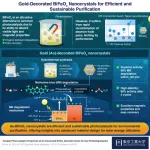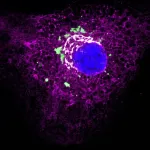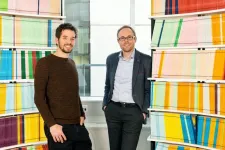(Press-News.org) DURHAM, N.C. – The unique circumstances arising from the COVID-19 pandemic altered a long-held convention that doctors provide care regardless of personal risk.
In a study assessing doctors’ tolerance for refusing care to COVID-19 patients, Duke Health researchers identified a growing acceptance to withhold care because of safety concerns.
“All the papers throughout history have shown that physicians broadly believed they should treat infectious disease patients,” said the study’s lead author, Braylee Grisel, a fourth-year student at Duke University School of Medicine.
“We figured our study would show the same thing, so we were really surprised when we found that COVID-19 was so different than all these other outbreaks,” Grisel said.
Publishing April 24, in the journal Clinical Infectious Diseases, the researchers analyzed 187 published studies culled from thousands of sources, including academic papers, opinion pieces, policy statements, legal briefings and news stories. Those selected for review met criteria for addressing the ethical dilemma posed by treating a novel infectious disease outbreak over the past 40 years.
Most articles -- about 75% -- advocated for the obligation to treat. But COVID-19 had the highest number of papers suggesting it was ethically acceptable to refuse care, at 60%, while HIV had the least number endorsing refusal of care at 13.3%.
The trendline stayed relatively stable across outbreaks occurring from the 1980s until the COVID-19 pandemic hit – with just 9% to 16% of articles arguing that refusing care was acceptable.
What changed with COVID? The authors found that labor rights and workers' protections were the chief reasons cited in 40% of articles during COVID, compared with only about 17%-19% for other diseases. Labor rights were cited the least often for HIV care, at 6.2%.
Another significant issue cited during the COVID pandemic was the risk of infection posed to doctors and their families, with nearly 27% of papers discussing this risk, compared to 8.3% with influenza and 6.3% for SARS.
“Some of these results may be because we had the unique opportunity to evaluate changing ethics while the pandemic was actively ongoing, as COVID-19 was the first modern outbreak to put a significant number of frontline providers at personal risk in the United States due to its respiratory transmission,” said senior author Krista Haines, D.O., assistant professor in the departments of Surgery and Population Health Sciences at Duke University School of Medicine.
The authors noted that the COVID pandemic had several unique characteristics that collectively altered the social contract between doctors and patients, potentially driving changes in treatment expectations. Such factors included:
• Shortages of resources available to care teams, including personal protective gear, hospital rooms, respirators, treatments and vaccines;
• Polarizing misinformation about vaccines, effective treatments and how the virus spread;
• Increased rates of reported mistreatment against staff from patients and their family members.
The authors note the ongoing debate over whether vaccination status should be considered in the decision to treat a patient.
“There was a great deal of discussion among frontline providers and ethicists on how best to allocate scarce resources,” the authors wrote. “Patients who refused vaccination were at a higher risk of complications while also putting other patients and providers at risk. Arguments were made based on reciprocity, medical triage, and personal responsibility to exclude patients who refused vaccines from consideration when ventilators and other resources were limited.”
Grisel said the study’s finding provides insight regarding how care should be provided in future pandemics. What had been a fairly solid expectation that physicians were obligated to provide care despite the risks to themselves now appears to have softened. It is unclear how these results may change in the future when the pandemic is less of an active threat.
“This study really shows how outside pressures in the sociopolitical sphere influence and affect doctors and care providers,” Grisel said. “In future pandemics, we may need to become more aware of how the risks and outside pressures of an active pandemic influence willingness to provide care. Health care systems can learn how to mitigate these influences to ensure that hospitals are adequately staffed to meet patient needs.”
In addition to Grisel and Haines, study authors include Kavneet Kaur, Sonal Swain, Laura Gorenshtein, Chinecherem Chime, Ellen O’Callaghan, Avani Vasireddy, Lauren Moore, Christina Shin, Michelle Won, Santita Ebangwese, Todd Tripoli, Stephanie Lumpkin, Zachary Ginsberg, Sarah Cantrell, Jennifer Freeman and Suresh Agarwal.
###
END
COVID-19 pandemic alters view that doctors are obligated to provide care
Previous infectious disease outbreaks such as HIV and SARS showed little impact on how doctors approached their obligation to treat patients
2024-04-24
ELSE PRESS RELEASES FROM THIS DATE:
This salt battery harvests osmotic energy where the river meets the sea
2024-04-24
Estuaries — where freshwater rivers meet the salty sea — are great locations for birdwatching and kayaking. In these areas, waters containing different salt concentrations mix and may be sources of sustainable, “blue” osmotic energy. Researchers in ACS Energy Letters report creating a semipermeable membrane that harvests osmotic energy from salt gradients and converts it to electricity. The new design had an output power density more than two times higher than commercial membranes in lab demonstrations.
Osmotic energy can be generated anywhere salt gradients are ...
On the trail of deepfakes, Drexel researchers identify ‘fingerprints’ of AI-generated video
2024-04-24
In February, OpenAI released videos created by its generative artificial intelligence program Sora. The strikingly realistic content, produced via simple text prompts, is the latest breakthrough for companies demonstrating the capabilities of AI technology. It also raised concerns about generative AI’s potential to enable the creation of misleading and deceiving content on a massive scale. According to new research from Drexel University, current methods for detecting manipulated digital media will not be effective against AI-generated video; but a machine-learning approach could be the key to unmasking these synthetic creations.
In a paper accepted ...
Virtual reality can motivate people to donate to refugee crises regardless of politics
2024-04-24
PULLMAN, Wash. – Political conservatives who watched a documentary on Syrian refugees with a virtual reality headset had far more sympathy for the people depicted in the film than those who viewed the same film on a two-dimensional computer screen.
Higher sympathy levels among the conservatives who watched the VR version of the documentary, “Clouds over Sidra,” resulted in a greater willingness to donate to the crisis, according to a study on the research published in New Media & Society.
Liberal participants in the study reported high levels of sympathy and ...
Holographic displays offer a glimpse into an immersive future
2024-04-24
Setting the stage for a new era of immersive displays, researchers are one step closer to mixing the real and virtual worlds in an ordinary pair of eyeglasses using high-definition 3D holographic images, according to a study led by Princeton University researchers.
Holographic images have real depth because they are three dimensional, whereas monitors merely simulate depth on a 2D screen. Because we see in three dimensions, holographic images could be integrated seamlessly into our normal view of the everyday world.
The result is a virtual and augmented reality display that has the potential to be truly immersive, the kind where you can move your head ...
Novel Au-BiFeO3 nanostructures for efficient and sustainable degradation of pollutants
2024-04-24
The need for sustainable and environment-friendly solutions has accelerated the global demand for green and renewable technologies. In this regard, semiconductor photocatalysts have emerged as an attractive solution, owing to their potential in mitigating pollutants and harnessing solar energy efficiently. Photocatalysts are materials that initiate chemical reactions when exposed to light. Despite their progress, commonly used photocatalysts suffer from reduced photocatalytic activity and a narrow operation range within the visible ...
It takes two to TANGO: New strategy to tackle fibrosis and scarring
2024-04-24
Researchers at the Centre for Genomic Regulation in Barcelona and the University of Cologne in Germany have developed a new experimental strategy to tackle scarring and fibrosis. Experiments with patient-derived human cells and animal models showed the strategy was effective, non-toxic and its effects reversible. The findings are published today in the journal Nature Communications.
Scarring occurs from the secretion and accumulation of various components – primarily proteins known as collagens – into the space between individual cells, usually occurring as a response to injury or damage. Excessive collagen secretion can also cause the buildup of fibrotic ...
Researchers aim to analyze pangenomes using quantum computing
2024-04-24
A new collaboration brings together a world-leading interdisciplinary team with skills across quantum computing, genomics, and advanced algorithms. They aim to tackle one of the most challenging computational problems in genomic science: building, augmenting and analysing pangenomic datasets for large population samples. Their project sits at frontiers of research in both biomedical science and quantum computing.
The project, which involves researchers based at the University of Cambridge, the Wellcome Sanger Institute and EMBL’s European ...
Ready and vigilant: immune cells on standby
2024-04-24
When pathogens invade the body, the immune system must react immediately to prevent or contain an infection. But how do our defence cells stay ready when no attacker is in sight? Scientists from Vienna have found a surprising explanation: They are constantly stimulated by healthy tissue. This keeps them active and ready to respond to pathogens. Based on this insight, future medications could be devised to selectively enhance our immune system’s attention. The study has been published in the journal Nature Immunology (DOI: 10.1038/s41590-024-01804-1).
Communication is crucial in immune defence. When ...
Securing competitiveness of energy-intensive industries through relocation: The pulling power of renewables
2024-04-24
“Our new study shows that renewable-scarce countries like parts of the EU, Japan and South Korea could save between 18 to 38 percent in production costs”, explains Philipp Verpoort, scientist at the Potsdam Institute for Climate Impact Research (PIK) and lead author of the study published in Nature Energy. “They could do so by relocating their production of industrial basic materials like green steel and chemicals based on green hydrogen to countries where renewable energy is cheap.” The use of renewable electricity and green hydrogen is ...
CAR T cell therapy targeting HER2 antigen shows promise against advanced sarcoma in phase I trial
2024-04-24
HOUSTON – (April 24, 2024) – Researchers at Texas Children’s Cancer Center and the Center for Cell and Gene Therapy at Baylor College of Medicine, Texas Children’s Hospital and Houston Methodist published results of a phase I clinical trial of a novel immunotherapy for high-risk sarcomas in the journal Nature Cancer.
The therapy uses chimeric antigen receptor (CAR) T cells engineered to target the HER2 protein, which is overexpressed on the surface of sarcoma cells. The HEROS 2.0 trial showed that this therapeutic approach is safe and is associated with clinical benefit.
“CAR T cell therapy has been a highly successful strategy for recurrent ...
LAST 30 PRESS RELEASES:
The impact of family dynamics on eating behaviour – how going home for Christmas can change how you eat
Tracing the quick synthesis of an industrially important catalyst
New software sheds light on cancer’s hidden genetic networks
UT Health San Antonio awarded $3 million in CPRIT grants to bolster cancer research and prevention efforts in South Texas
Third symposium spotlights global challenge of new contaminants in China’s fight against pollution
From straw to soil harmony: International team reveals how biochar supercharges carbon-smart farming
Myeloma: How AI is redrawing the map of cancer care
Manhattan E. Charurat, Ph.D., MHS invested as the Homer and Martha Gudelsky Distinguished Professor in Medicine at the University of Maryland School of Medicine
Insilico Medicine’s Pharma.AI Q4 Winter Launch Recap: Revolutionizing drug discovery with cutting-edge AI innovations, accelerating the path to pharmaceutical superintelligence
Nanoplastics have diet-dependent impacts on digestive system health
Brain neuron death occurs throughout life and increases with age, a natural human protein drug may halt neuron death in Alzheimer’s disease
SPIE and CLP announce the recipients of the 2025 Advanced Photonics Young Innovator Award
Lessons from the Caldor Fire’s Christmas Valley ‘Miracle’
Ant societies rose by trading individual protection for collective power
Research reveals how ancient viral DNA shapes early embryonic development
A molecular gatekeeper that controls protein synthesis
New ‘cloaking device’ concept to shield sensitive tech from magnetic fields
Researchers show impact of mountain building and climate change on alpine biodiversity
Study models the transition from Neanderthals to modern humans in Europe
University of Phoenix College of Doctoral Studies releases white paper on AI-driven skilling to reduce burnout and restore worker autonomy
AIs fail at the game of visual “telephone”
The levers for a sustainable food system
Potential changes in US homelessness by ending federal support for housing first programs
Vulnerability of large language models to prompt injection when providing medical advice
Researchers develop new system for high-energy-density, long-life, multi-electron transfer bromine-based flow batteries
Ending federal support for housing first programs could increase U.S. homelessness by 5% in one year, new JAMA study finds
New research uncovers molecular ‘safety switch’ shielding cancers from immune attack
Bacteria resisting viral infection can still sink carbon to ocean floor
Younger biological age may increase depression risk in older women during COVID-19
Bharat Innovates 2026 National Basecamp Showcases India’s Most Promising Deep-Tech Ventures
[Press-News.org] COVID-19 pandemic alters view that doctors are obligated to provide carePrevious infectious disease outbreaks such as HIV and SARS showed little impact on how doctors approached their obligation to treat patients




